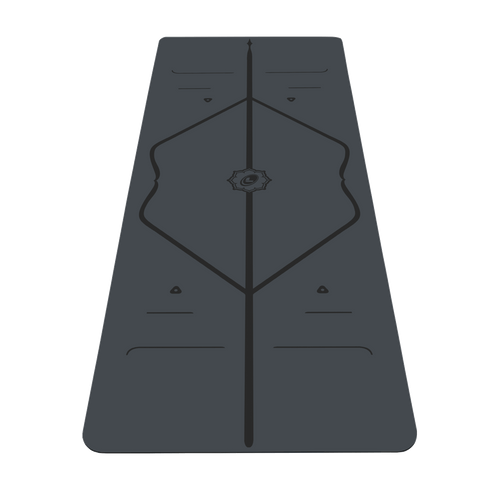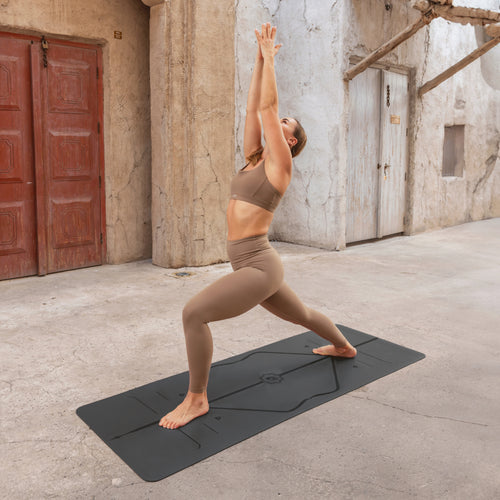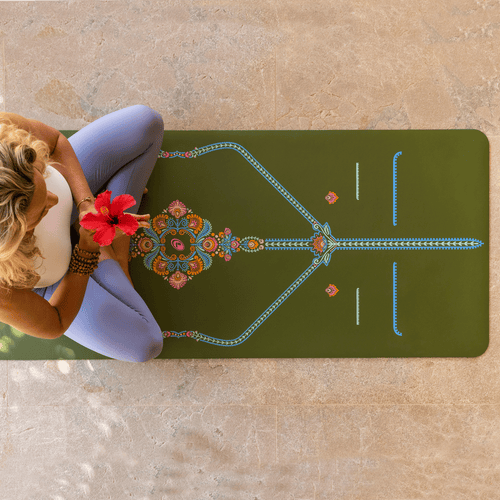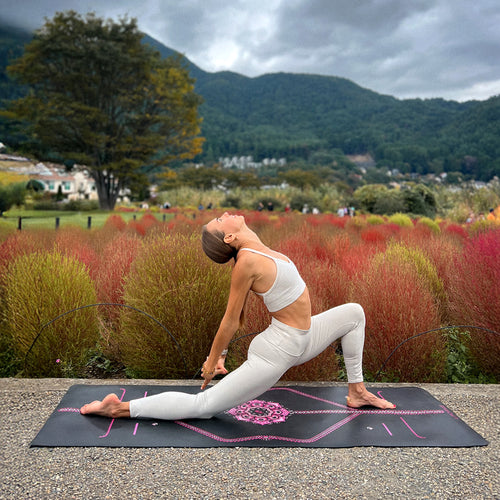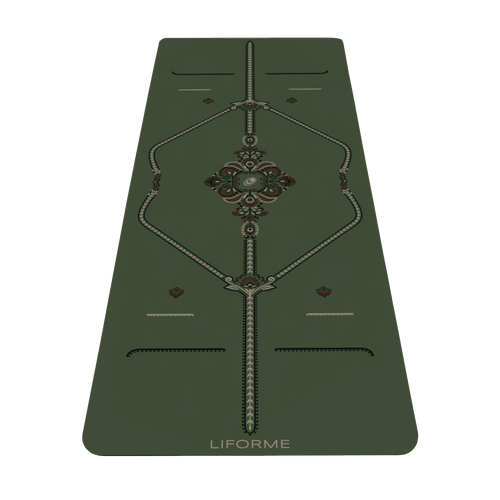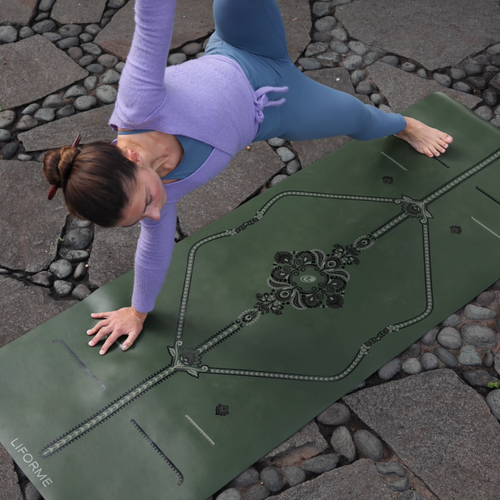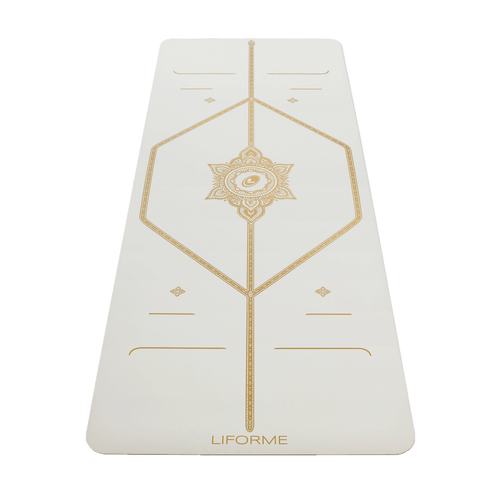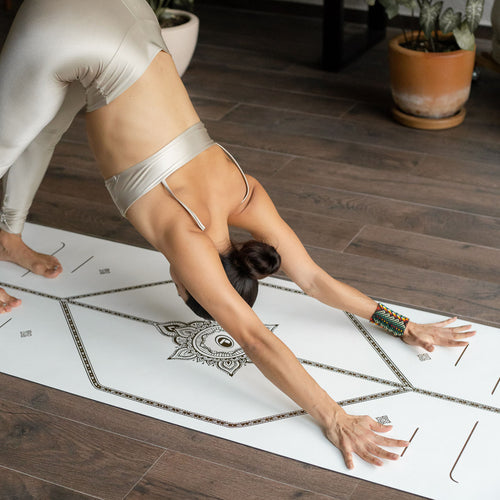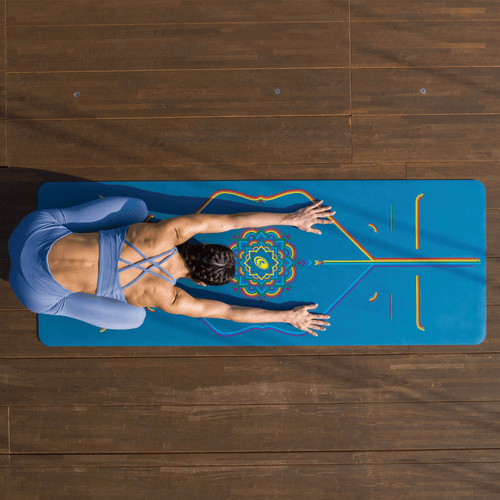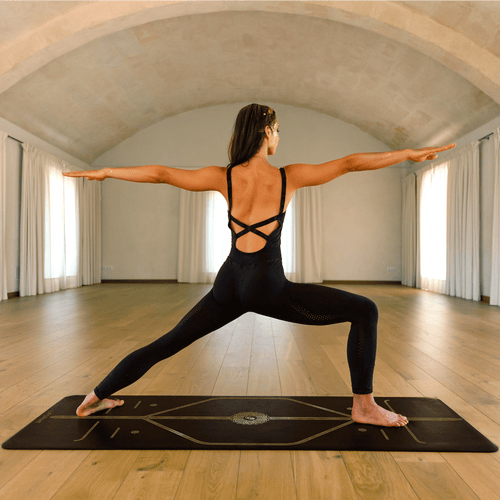Starting Yoga can be intimidating, but we’ve gathered all our best information to help beginners feel confident. By the end of this guide, you’ll be one step closer to getting on the mat with confidence and ease.
How to Start Doing Yoga & How Often a Beginner Should Practice
Don’t put off trying yoga because you don’t think you have enough time to do it adequately. Yoga can be made to fit your schedule, not the other way around. If you can only go to class once a week, start there.
What often happens is that once you experience how yoga makes you feel, you’ll want to do more, not less.
Two or three classes a week is a pretty good goal, but you can also substitute shorter sessions at home (even a 10-minute morning routine) once you have an idea of what to do.
Even a little goes a long way, especially whilst you’re a yoga beginner.

What are the Benefits of Yoga?
The practice of yoga has numerous physical and mental benefits.
-
Physically, doing yoga postures makes you stronger and more flexible, both of which are key factors in healthy ageing.
-
Greater core strength, in particular, leads to improved balance. Learning about alignment improves body awareness and posture. Mindful movement and strengthening the support muscles help keep joints healthy.
-
The full-body range of motion encouraged by yoga helps counter the effects of too much time spent sitting at work or in cars, things that affect so many of us nowadays.
-
Many people who are active and into sports also find that yoga helps them avoid injury and improve performance.
-
Mentally, yoga asana and the associated practices of breath control and meditation are proven tools for relaxation, helping many people who have trouble sleeping and reducing stress.
A healthier body and mind leads to an improved sense of well-being. In short, yoga helps you feel better!
8 Yoga Poses for Beginners
We’ve mentioned yoga postures but you still may not know exactly what that means, so here are a few beginner yoga poses that you’re likely to encounter early in your practice.
You may find some of these poses look familiar but you’ll be doing them with a completely different mindset than you had before. And some are going to be completely new shapes to you.
Don’t feel like you need to master them ahead of time. However, having a mental image of these beginner poses will help you move your body in their general direction once you do hit the mat.

Downward Facing Dog (Adho Mukha Svanasana)
This is probably yoga’s most ‘famous’ pose with good reason. It’s a great yoga pose for beginners that works the whole body and is often done many times in a yoga class.
Quick tip for beginners: Picture Downward Facing Dog as a big inverted V shape with your butt forming the apex. Pressing strongly through your palms helps you move your hips back and take more weight into your legs.

Plank Pose (Phalakasana)
If you’ve ever done push-ups, Plank Pose may seem like familiar ground.
You want to make sure you’re using yoga alignment in this posture. That means shoulders over your wrists and a straight line from the crown of your head to your heels.
Quick tip for beginners: Lowering your knees to the ground is fine. Just don’t let it affect the position of your shoulders and hips.

Mountain Pose (Tadasana)
Mountain Pose really highlights the difference between just standing and standing with attention to every detail of how your body is aligned.
Quick tip for beginners: Build your pose from the feet up.

Standing Forward Fold (Uttanasana)
Another posture that probably looks familiar but will feel different because you’ll be doing it with a focus on your alignment and breath.
Most people lean their weight too far back in this position. Try to bring your weight forward into the balls of your feet so that your hips come over your ankles.
Quick tip for beginners: It’s absolutely fine to bend your knees, just make sure you try to keep your weight equally distributed to all four corners of your feet.

Warrior I (Virabhadrasana I) and Warrior II (Virabhadrasana II)
Now we’re coming to a few shapes that are pretty unique to yoga and may be unfamiliar to you as a beginner. Just know that these standing postures are considered very challenging, even for experienced yogis.

They get into balance and body awareness and all the things you are going to develop over time with this practice.
Quick tip for beginners: We’ve written extensively about the difference in hip alignment between Warrior I and Warrior II. Once you’ve done them both for a little while, we recommend delving into our more detailed articles on these poses. For now, remember that in Warrior I the hips face forward, while in Warrior II they face the side.

Triangle Pose (Trikonasana)
Triangle Pose is another classic posture that is done in many standing yoga sequences.
It often follows Warrior II since they have much the same hip alignment. It’s a pose that benefits a lot from the use of props, particularly a block.
Quick tip for beginners: Take a block under your bottom hand so that you don’t have to bend your front knee in order to reach the floor with your hand. This is an example of how using a prop can help you avoid compromising your alignment.
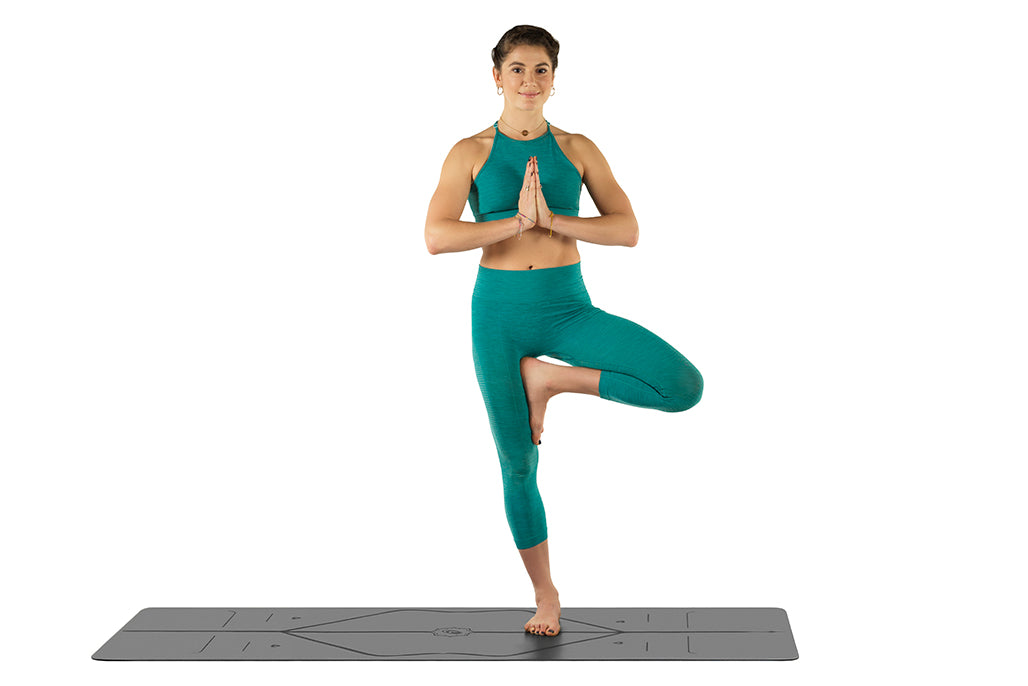
Tree Pose
Although many of yoga’s standing poses involve balance (see Warrior I), Tree Pose is often the first ‘standing on one leg’ balancing posture that beginners tackle when they start their yoga journey. And it may surprise you how difficult it is at first!
Quick tip for beginners: Put your lifted foot anywhere on the inside of the standing leg except on the side of the knee since that puts unnecessary pressure on your joint.

Child’s Pose (Balasana)
Ah, finally a place to rest and recover! Child’s Pose (or Balsana) is super important to learn early on because it’s the international yoga symbol for ‘I’m taking a personal moment, I’ll be with you shortly.’
Yoga teachers always say to listen to your body and take rest when you need to, whether or not the class goes there. This is the position to do that.
Quick tip for beginners: Take Child’s Pose whenever you need it!
What Happens in a Beginner Yoga Class?
Yoga practice today most commonly consists of postures (asana), breathing (pranayama), and meditation in varying proportions. It can be done in a group class, through private instruction, or at home. In most cases, attending a group class is the easiest way to get started.
Yoga classes are usually 60-90 minutes long. Remove your shoes and silence your phone (no beeping, no buzzing!) before entering the yoga room. Students generally arrange their mats in rows facing the front of the room.
In a beginners’ yoga class, there may be a good bit of demonstration by the teacher, so make sure you can see them.
The class will often begin with focusing everyone’s attention on their breathing since this is a good way to start to feel present and centred.

Warming Up
Warm-up stretches may come next, leading into a series of more strenuous standing poses. Deeper stretching and backbends often follow once the body is warm. Each class ends with lying on your mat in total relaxation for a few minutes.
This is known as Savasana (which literally means Corpse Pose, corpses tending to be a good reference point for lying still). This period of stillness helps your body and your brain absorb the benefits of the intense physical experience you’ve just had.
What Else Can Happen in a Beginner Yoga Class?
Many styles of yoga follow this basic structure, though there is a lot of room for variation within it. Oftentimes, breath awareness is incorporated with the postures.
Sometimes there may be a short seated meditation at the end of practice. Other times, the sound ‘OM’ (signifying the divine, or Universal) is chanted by the group and often class will end with the spiritual salutation ‘namaste’ to thank the teacher and the group for practising together.
Namaste is often described as meaning ‘the light in me honours the light in you’.
Don’t Be Scared!
Although attending class can be a bit intimidating the first time, it quickly becomes more comfortable. Choose a yoga class for beginners, go in with an open mind, and only do as much as you can. No one expects you to know what’s going on and everyone who does yoga has been where you are.
What is Yoga Alignment and Why is it Important for Beginners?
If you’re new to yoga, alignment might be a word you associate more with your car tyres than with your body. Once you start, however, you’re likely to hear this word a lot.
Yoga Alignment refers to the precise way that each yoga pose is done to maximise the physical benefits and minimise the risk of injury.
Often, this means stacking your joints for the greatest structural support, such as knee over ankle in a lunge or shoulders over pelvis in a standing posture.
At first, alignment instruction might seem finicky and random but it pretty quickly becomes more intuitive and follows a logical system of building a strong foundation from the ground up.
Props, such as blocks and straps, are often employed to help students practice safely as their bodies become more open and stronger over time.
It’s better to do a pose with good alignment integrity using props than to make alignment compromises that lead to instability and postural habits that are hard to break.
Studios provide blocks and straps, so unless you plan to do a lot of yoga at home, there’s no need to get your own at first. A yoga mat with alignment markings is a big help.
Yoga Equipment for Beginners
We’ve already mentioned the most important bit of yoga equipment: the mat. But wait, you’re thinking, don’t you just happen to sell mats? I’m a little suspicious of this advice. So let’s clear the air. Yes, it’s true that we sell mats. But it also happens to be true that all you really need to get going is a mat and your body.
Most yoga studios rent mats to students for class and this is a perfectly fine way for beginners to get started. Eventually, you’ll begin to see the benefits of having your own mat (for instance, you control how and when it gets cleaned).
When you’re ready to choose one, consider factors like grip, support, alignment assistance, and sustainability to find the best fit for your needs.
You probably already own something you can wear for yoga. Stretchy workout pants or shorts, a somewhat fitted top (too loose and it will be falling in your face every time you bend over), maybe a sports bra. Yoga is done barefoot.
Is Yoga Right for You?
Are you a human? Then yes.
Some people worry that they’re not flexible enough, young enough, or thin enough to start doing yoga. But yoga really is for everyone. It’s an infinitely adaptable practice. The only people who can possibly take a pass on yoga are those who already have other practices in their lives that give them the same mental and physical benefits. And even they might want to give it a shot.
The History of Yoga (the Very Short Version)
Yoga originated in India primarily as a philosophy of the universe (meaning, like, everything). For much of yoga’s ancient history, the physical side consisted primarily of just a few seated postures and breath control to support the practice of deep meditation. In the late 19th and early 20th centuries, physical postures began to take a more central role.
In the 1970s, Westerners travelling in India began bringing the teachings of Indian yoga masters back home and, in some cases, adapting them to fit contemporary lifestyles. That was the beginning of the popular European/American yoga movement as we now know it.
The more you know, the less there is to fear. By reading about yoga, you’ve taken the first step. The next step must be to experience it in your body because that’s where yoga’s power lies.
We hope that this Yoga for Beginners Guide took you a little closer to getting on a mat so that you can begin to discover the many ways that doing yoga improves your life.
Yoga for Beginners FAQs
What are the best beginner yoga poses to try at home?
Starting yoga at home is a great way to practice at your own pace. Some of the best beginner yoga poses include Downward Facing Dog, Child’s Pose, Mountain Pose, and Standing Forward Fold.
These simple poses help build strength, flexibility, and balance while allowing you to ease into a regular yoga practice. You can start with short sessions and gradually increase the time as you become more comfortable.
How often should a beginner practice yoga to see results?
For beginners, practicing yoga two to three times a week is ideal to start seeing physical and mental improvements. However, if you’re just getting started, it’s important not to overwhelm yourself.
Start with shorter sessions, even 10-15 minutes daily, and increase your practice frequency as you feel more comfortable. Consistency is key for building strength, flexibility, and mindfulness over time.
Can I start yoga if I’m not flexible enough?
Yoga is specifically designed for beginners of all fitness levels, including those who aren’t the most flexible. Yoga is about gradual progress, and flexibility improves with consistent practice. Starting with basic poses and using props to achieve proper alignment can help you ease into poses, and your flexibility will naturally improve over time.








